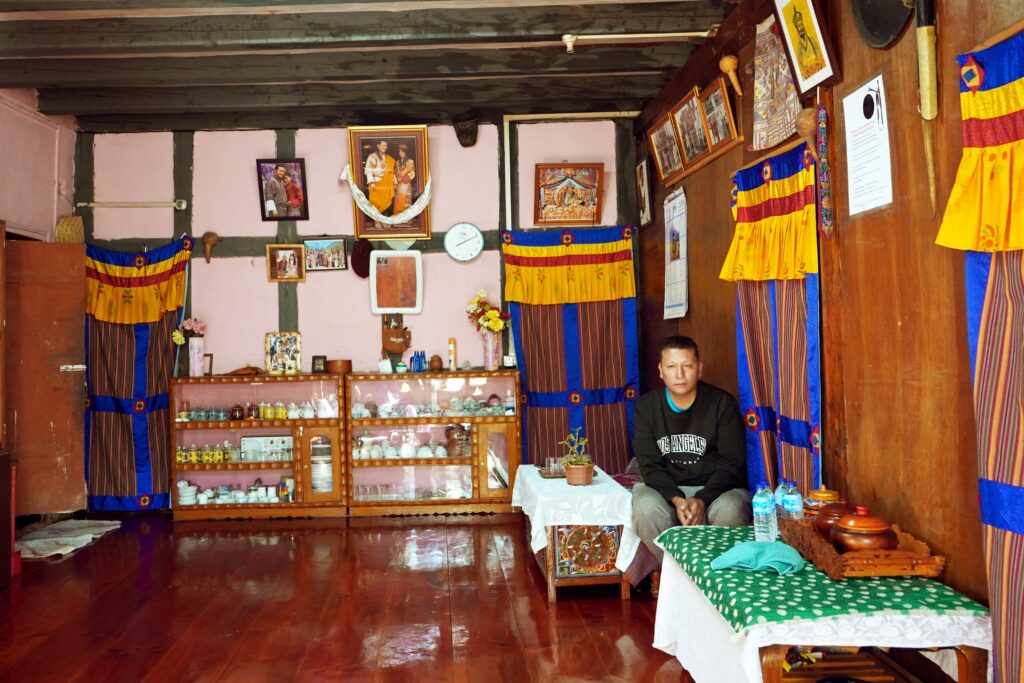In September, I traveled with Little Bhutan to Haa, the last district in western Bhutan to open to tourists. Haa lies just a 90-minute drive from Paro International Airport but sees fewer visitors. Most people know little about the district beyond its guardian deity, Chhundu, who reportedly rivals Gyenyen, Thimphu’s local deity.
On our three-hour drive from Thimphu, which included stops for photos, I stayed awake most of the way. After crossing Chhuzom, we passed our first bridge and three Paro villages: Dawakha, Jabana, and Bitekha. I’ve always wondered why Jabana and Bitekha are considered part of Paro. After joining the old Haa highway, we noticed road construction led by the Indian Military Training Team (IMTRAT) and witnessed villagers gathered at a local shop’s parking lot, waiting to greet a local lama.
Haa Attractions
In Haa, we visited Lhakhang Karpo and Nagpo, two temples near our farm stay. “Karpo” means white, and “Nagpo” means black in Dzongkha. Tibetan King Songtsen Gompo reportedly built these lhakhangs as part of 108 temples constructed in a single day during the 8th century. Lhakhang Nagpo, situated above Lhakhang Karpo, requires a short hike and Lhakhang Karpo is home to Haa’s official monk body. Bhutan’s National Day was celebrated here in 2017, with His Majesty the King attending the event.



We then had lunch in Haa town. Our host, dressed in a kira without the usual jacket, served a group of tourists before attending to us. I listened for hints of the Haap accent, which closely resembles the Parop accent, and was pleased to catch traces of it. After lunch, we drove toward Damthang, a military base marking the end of Haa. Along the way, we passed the IMTRAT canteen, a golf course, and a fishery. The canteen serves authentic Indian dishes like dosa, samosa, and idli at affordable prices.
Night at the Farm Stay
We arrived at the farmhouse late, greeted by the owner, Kinley Wangchu, who offered to carry our bags. Kinley, a tall man with an distant appearing personality, reminded me of my paternal relatives—though by the end of our four-hour conversation, I realized he didn’t actually resemble them.
Inside, we were struck by the home’s polished orange floors. After arranging our bags, we settled in for tea and an engaging conversation with Kinley. Over four hours, he shared stories about his children, views on the emerging farm-stay industry, and local village life. Only one of his three children remains in Bhutan, working in national broadcasting. The walls displayed a family sword and photos with the current Prime Minister, who also hails from Haa.

Kinley spoke about the high cost of mobile data and mentioned taking Indian guests to the IMTRAT canteen. He’s part of an association of farmhouse owners who keep in touch through WeChat. I found his optimism refreshing, especially in light of the country’s recent trend of young people migrating to Australia.
Haa Panorama Hike
The next morning, after breakfast, we drove to Yangthang Goenpa, a spiritual site located above the grounds of Haa’s guardian deity. The Haa Community Tourism Group, which includes guides, cooks, and drivers, established and developed the trail in 2021. I spoke with Wangdi Tshetan, a Haa native, freelance guide, and group member. He shared how, during COVID-19, he and friends wanted to contribute to their community, resulting in the trail’s creation. Their hard work, without heavy machinery, saw the route completed within a year. Wangdi mentioned future plans for eco-lodges in lower Haa, which has subtropical climate, rafting, and fly-fishing opportunities.


We completed the hike in four and a half hours.
Haa’s Flora and Fauna
Haa boasts a unique climate, where elevations range from 800 meters to 4000 meters above sea level, making it a year round destination and a pleasant winter gateway.
Haa’s landscape is home to the Red Poppy, Red Panda, Takin, tiger, Himalayan Tahr, rhododendron, wild mushrooms, and the rare White Poppy, unique to the region. For a chance to see the endangered Red Panda, visitors should head to Tergola, Haa’s highest point, before dawn. Haa is also home to the Jigme Khesar Strict Nature Reserve, Bhutan’s only strict nature reserve, which includes parts of the renowned Nub Tshona Patra Trek.
Book your trip to Bhutan today! Contact us at [email protected] or call +975 1711-2338 any time, anywhere!


